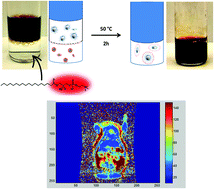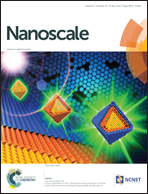Phosphocholine-decorated superparamagnetic iron oxide nanoparticles: defining the structure and probing in vivo applications†
Abstract
Superparamagnetic Iron Oxide Nanoparticles (SPIONs) are performing contrast agents for Magnetic Resonance Imaging (MRI). A functionalization strategy for SPIONs based on hydrophobic interactions is a versatile approach easily extendable to several kinds of inorganic nanoparticles and suitable for obtaining stable and biocompatible systems. Here we report on the original preparation of functionalized SPIONs with an 8 nm radius exploiting the hydrophobic interaction between a phosphocholine and an inner amphiphilic. With respect to other similarly functionalized SPIONs, characterized by the typical nanoparticle clustering that leads to large aggregates, our phosphocholine-decorated SPIONs are demonstrated to be monodisperse. We report the in vitro and in vivo study that proves the effective applicability of phosphocholine-decorated SPIONs as MRI contrast agents. The versatility of this functionalization approach is highlighted by introducing on the SPION surface a ruthenium-based potential antitumoral drug, named ToThyCholRu. Even if in this case we observed the formation of SPION clusters, ascribable to the presence of the amphiphilic ruthenium complex, interesting and promising antiproliferative activity points at the ToThyCholRu-decorated SPIONs as potential theranostic agents.


 Please wait while we load your content...
Please wait while we load your content...